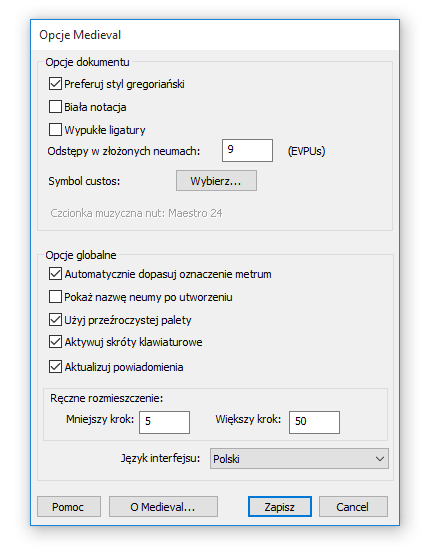The Medieval Options Dialog Box (polski)
The Medieval Options Dialog Box
The Medieval Options dialog box is where you can adjust Medieval parameters for your scores or for the general behavior of Medieval 2.
There are two sections:
Document Options (Opcje dokumentu)
(These options can be adjusted for each score.)
- Biała notacja: check this if you want “white” shapes for notes or ligatures (but you can toogle any time between black and white with the Notehead tool.)
- Wypukłe ligatury: check this if you want convex rather than concave ligatures.
- Preferuj styl gregoriański: If checked, the high part of the podatus will have specific look.
- Odstępy w złożonych neumach: the default space inbetween parts when creating a compound neume.
- Symbol custos: this is where the default custos symbol can be chosen.
- Czcionka muzyczna nut: this is normally “Neuma 24” be there might be more font style available in the future.
Global Options (Opcje globalne)
(These options are global for all scores.)
- Automatycznie dopasuj oznaczenie metrum: normally, you should keep this option always checked!
- Pokaż nazwę neumy po utworzeniu: check this if you want Medieval to send you a friendly notification with the name of the neume just created.
- Użyj przeźroczystej palety: Medieval will fade the tool palette automatically if not in focus.
- Aktywuj skróty klawiaturowe: if you currently do not use Medieval, it is recommended to uncheck this.
- Aktualizuj powiadomienia: check this if you want Medieval to (gently) notify you when an update is available.
- Ręczne rozmieszczenie, Mniejszy/Większy krok: this rules the spaces used by the Nudge Tool.
- Język interfejsu: select your language of choice for Medieval 2 user interface (the other parts of Finale won't be affected!)

![]() See the Options dialog box in other languages:
See the Options dialog box in other languages:
Learn more
- Explore the Medieval menu.
- Explore the Tool Palette.
✶ ✶
✶
Created with the Personal Edition of HelpNDoc: Free EPub producer

